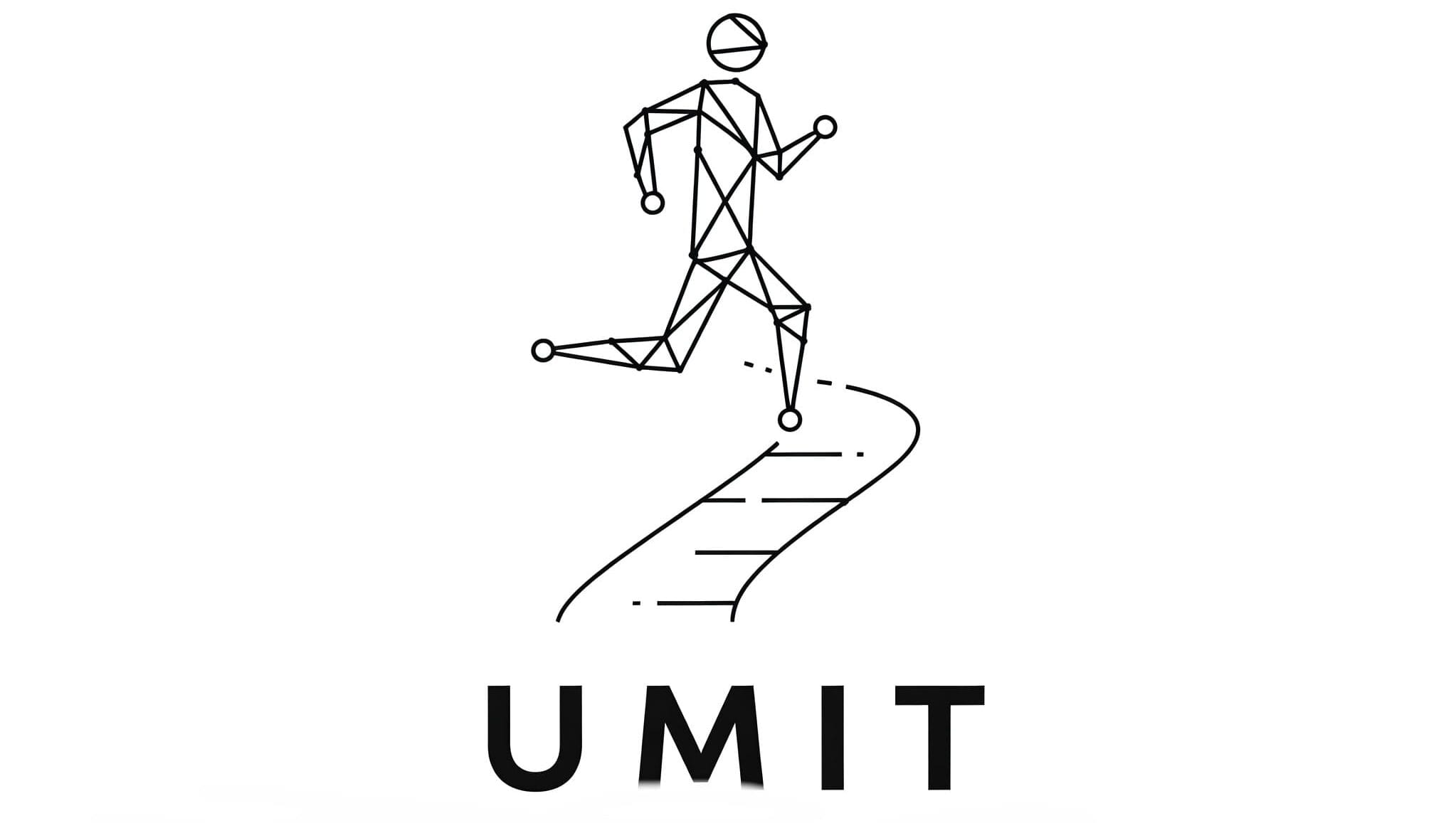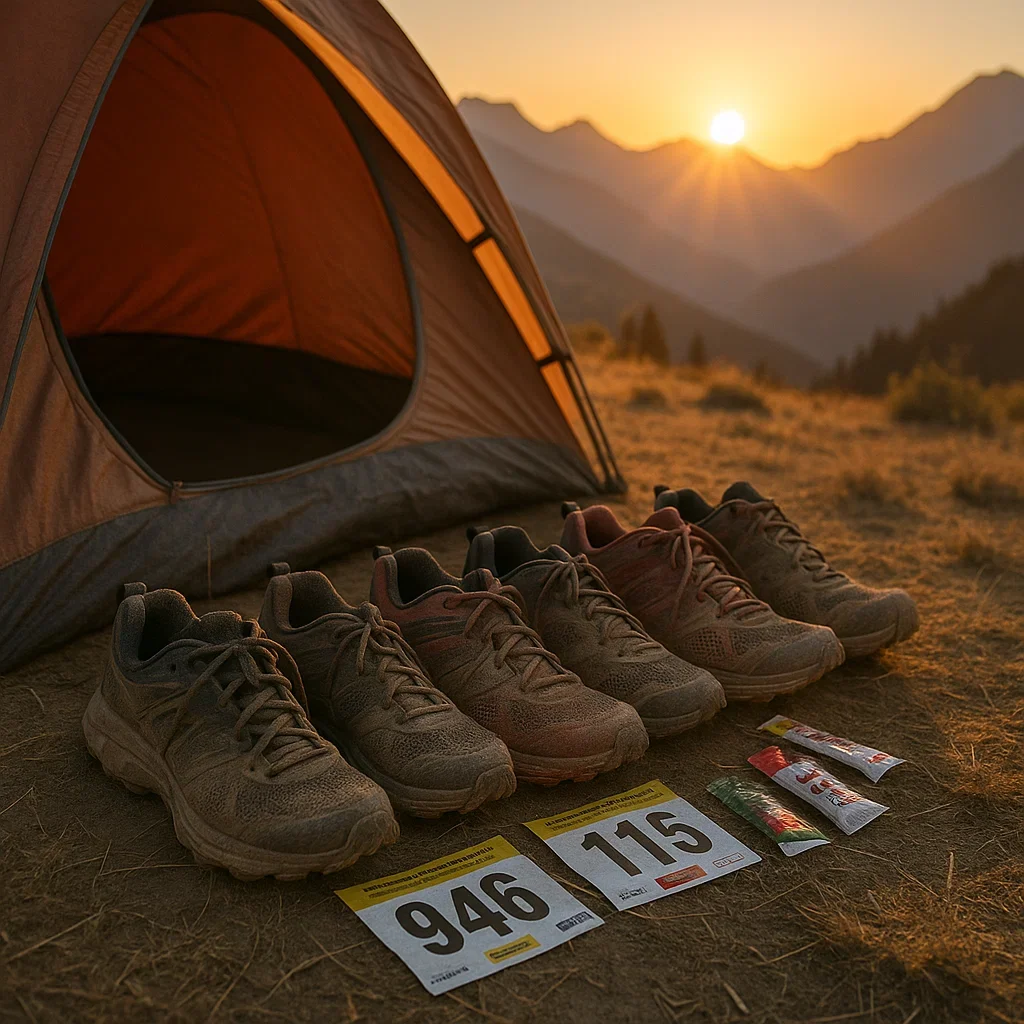⛰️👟⏳ Best Trail Running Shoes for Multi-day Ultra Marathons (6 Days)
Multi-day ultra marathons push gear (and humans!) beyond normal limits. From sunrise starts to midnight miles, through mud, rain, heat and blisters, your choice of trail running shoes is the #1 factor that can make—or break—your multi-stage adventure.
🦶✨ In this guide: You’ll discover the best trail shoes for 6-day stage races, why durability and fit matter more than brand, and how real finishers handle swelling, weather, and fatigue. We’ll break down expert picks, rotation tips, foot care hacks, and strategies that will help you conquer every stage—no matter how tough the course (or your competition) gets!
🏅👟 What Makes a Shoe Great for Multi-day Ultra Marathons?
A shoe that excels in a 50K or even a 100-mile race can totally fall apart—or destroy your feet—over six brutal days. Here’s what sets “multi-day ultra shoes” apart from the pack:
- Extreme Durability 🛡️ — Uppers, midsoles, and outsoles must survive mud, rain, rocks, and endless abrasion. Weak shoes fail by day three.
- Consistent Comfort 💤 — Cushioned but not mushy, roomy enough for swelling, and gentle on hot spots—even after 200km+.
- Excellent Drainage & Fast Drying 💧 — Breathable mesh and quick-drain designs keep feet healthy after river crossings or surprise storms.
- Secure Fit & Toe Protection 🦶 — A dialed fit stops blisters and black toenails. Reinforced toe guards are a must for rocky stages.
- Superior Grip for All Conditions 🌦️ — Reliable traction on mud, sand, rock, and grass means you can move with confidence, rain or shine.
- Versatility for Changing Terrain 🌍 — Multi-day ultras throw everything at you—look for shoes that adapt, not specialize too narrowly.
🥇👟 Top Trail Running Shoes for Multi-day & Stage Races (2025)
With its extra-wide toe box and 0mm drop, the Olympus 6 shines in stage races where swelling is inevitable. The Vibram Megagrip outsole offers solid grip across technical terrain, while the high stack cushioning softens brutal daily mileage.
Weight: 312g | Drop: 0mm | Toe box: Wide | Durability: ★★★★☆
If your stage race includes long runnable sections and smooth fire roads, the Caldera 7 is a dream. Massive stack height cushions the impact, and the updated TrailTack outsole handles light terrain with ease.
Weight: 312g | Drop: 6mm | Toe box: Medium/Wide | Durability: ★★★★☆
Built with Graphene Grip and a flexible midsole, this tank of a shoe thrives in wet, rocky, unpredictable terrain. The upper drains well, and the deep lugs hold tight when the trail turns sloppy.
Weight: 300g | Drop: 6mm | Toe box: Medium | Durability: ★★★★★
Featherweight and responsive, this elite racer’s dream shoe delivers precision and agility on technical ground. Best used for shorter stages or fast final days when speed counts more than cushion.
Weight: 285g | Drop: 8mm | Toe box: Narrow | Durability: ★★★☆☆
Bombproof toe protection, Vibram outsole, and enough cushion to handle back-to-back elevation stages make this a great all-rounder for mountainous stage races. Surprisingly light for its armor.
Weight: 295g | Drop: 6mm | Toe box: Medium | Durability: ★★★★☆
🔁👟 How to Rotate Shoes in 6-Day Multi-day Ultra Marathons
One pair of shoes won’t survive six full days—and even if it does, your feet might not. Shoe rotation is the key to managing swelling, terrain changes, and cumulative fatigue. Here’s how smart runners approach it:
- 👟 Primary Workhorse: Cushioned, durable shoe for 60–70% of your mileage (days 1, 2, 4)
- 🛡️ Backup / Recovery Shoe: Roomier toe box or zero-drop model to manage swelling (day 3, 5)
- 🚀 Final Day Shoe: Lightweight, responsive option for fast finish (day 6)
Don’t just rotate shoes—rotate sock types. Mix toe socks (Injinji), double-layers (Wrightsock), and wool blends to avoid repetitive friction. Fresh, dry socks = longer lasting feet.
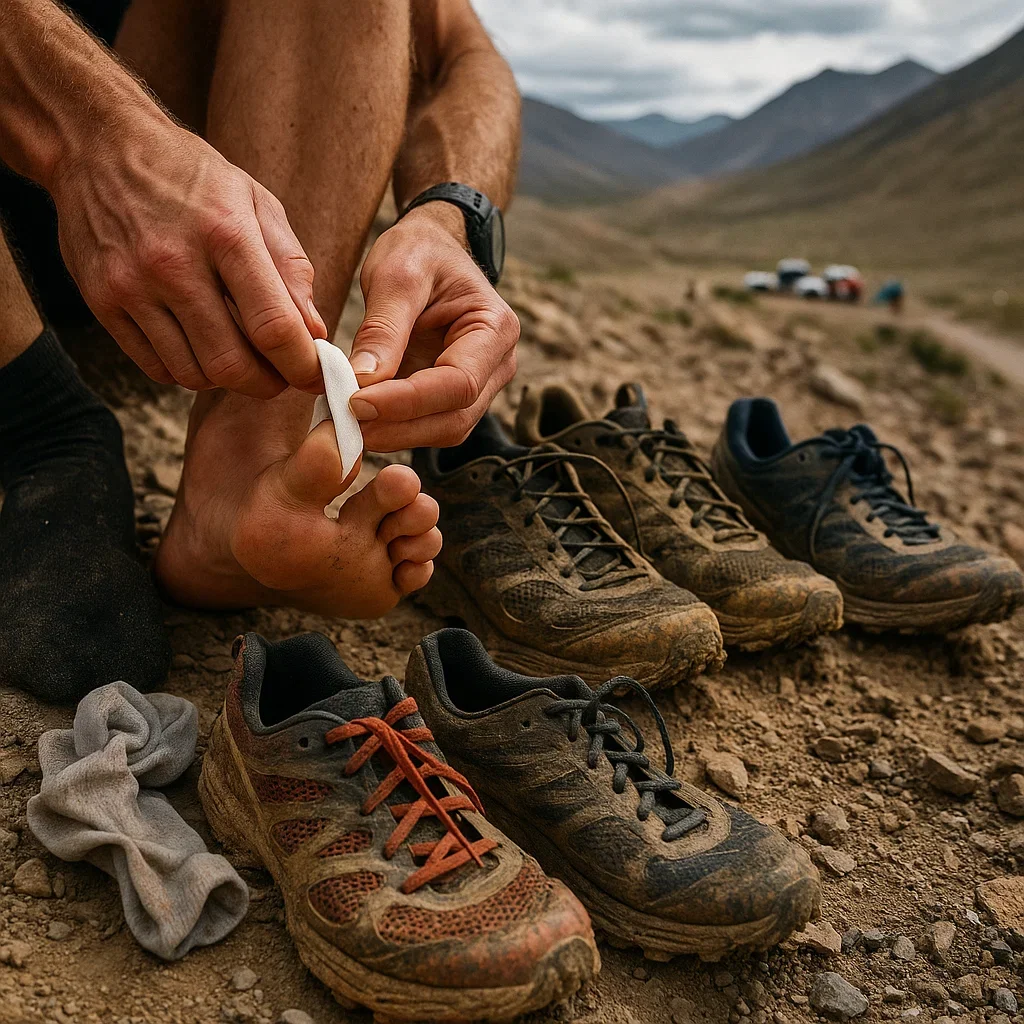
🦶🩹 Foot Care Essentials for Multi-day Ultra Runners
- Pre-tape toes, heels, and arches with Leukotape, RockTape, or KT tape—do this every morning.
- Lubricate feet (Squirrel’s Nut Butter, Trail Toes, or Vaseline) before every stage and after each sock change.
- Change into dry socks at least twice a day. Avoid cotton; use technical or wool blends.
- Never ignore a hot spot—stop and fix it at the first sign!
- Trim toenails straight and smooth edges with a file before race week.
- Moisturize feet in the days leading up to the race (but avoid slippery creams on race mornings).
- Use foot powder or zinc oxide to reduce moisture and friction during hot days.
- Mix toe socks (Injinji), double-layers (Wrightsock), and wool blends (Darn Tough, Smartwool).
- Test sock/shoe combos in long training blocks—never experiment during race week.
- Pack at least two pairs per day; keep backups dry in sealed bags.
- Drain blisters with a sterile needle and cover with zinc oxide tape or hydrocolloid bandage.
- Change socks immediately after repairs.
- Monitor for infection, especially in hot or wet conditions.
🛡️🌦️ Durability, Weather, and Trail Surface: Picking the Right Outsole
In a 6-day ultra, your shoe’s outsole is more than just rubber—it’s your lifeline. Every surface, every storm, every mile puts your grip, protection, and shoe life to the test. Here’s how to match your outsole to the challenge:
- Vibram Megagrip & Graphene Grip: Top picks for max wear resistance on rocky and abrasive courses.
- TrailTack (Brooks), Contagrip (Salomon): Reliable for mixed conditions and extended mileage.
- Rotate two pairs if your race is especially rocky—one shoe can get shredded after 100+ miles.
- Wet/Muddy: Deep lugs (Inov-8 Trailfly, Salomon Speedcross) clear mud quickly, preventing loss of grip.
- Dry/Hardpack: Flatter lugs or hybrid outsoles reduce drag and increase comfort (Brooks Caldera, Altra Olympus).
- Avoid waterproof membranes unless conditions demand—breathability matters more over six days.
- Technical/Rocky: Grippy, tough compounds and reinforced toe caps help prevent injuries and preserve outsole life.
- Sandy or Grass Stages: Flexible, lighter outsoles save energy and reduce sand buildup.
- On multi-surface races, prioritize versatility—avoid shoes with “extreme” lug patterns unless it’s a known mudfest!
🎙️👟 Real Stories: Shoe Choices from 6-Day Race Finishers
“I started in the Hoka Speedgoat 5 for day 1 and 2, which gave me great cushion. On the third day—after a wet descent—I switched to Inov-8 Trailfly G 300 Max. For the final stage, I used Salomon S/Lab Ultra 4 and felt light on my feet.”
Why it worked: Cushion → Grip → Speed. A perfect rotation for variable alpine terrain.
“I ran the whole race with two pairs of Altra Olympus 5. One for the first half, one fresh for the second. The zero drop and wide toe box saved my feet from swelling damage.”
Why it worked: One shoe model, two pairs—sand, heat, and swell-proof strategy.
“Day 1 I used Brooks Caldera 6 for max comfort. But when the trail turned into a swamp, I switched to Salomon Speedcross—the lugs saved me. For the final stage, I pulled out a pair of Topo MTN Racer I had pre-wet and broken in.”
Why it worked: Terrain-matching rotation with aggressive grip and fast drainage.
📊 Comparison Table – Multi-day Ultra Shoe Showdown
| Model | Best For | Weight | Drop | Toe Box | Durability | Key Strength |
|---|---|---|---|---|---|---|
| Altra Olympus 6 | Swollen Feet / Zero Drop | 312g | 0mm | Wide | ★★★★☆ | Supreme comfort & room, great for long swelling |
| Brooks Caldera 7 | Cushion / Smooth Trails | 312g | 6mm | Medium/Wide | ★★★★☆ | Massive stack height, softest ride |
| Inov-8 Trailfly G 300 Max | Mud / Technical Terrain | 300g | 6mm | Medium | ★★★★★ | Indestructible grip, drains well, agile |
| Salomon S/Lab Ultra 4 | Speed / Aggressive Racing | 285g | 8mm | Narrow | ★★★☆☆ | Featherweight, fast, precise |
| Merrell Agility Peak 5 | Rocky / Technical Stages | 295g | 6mm | Medium | ★★★★☆ | Bombproof protection, Vibram outsole |
| Hoka Speedgoat 5 | All-rounder / Ultra Cushion | 291g | 4mm | Medium | ★★★★☆ | High cushion, trusted for all terrains |
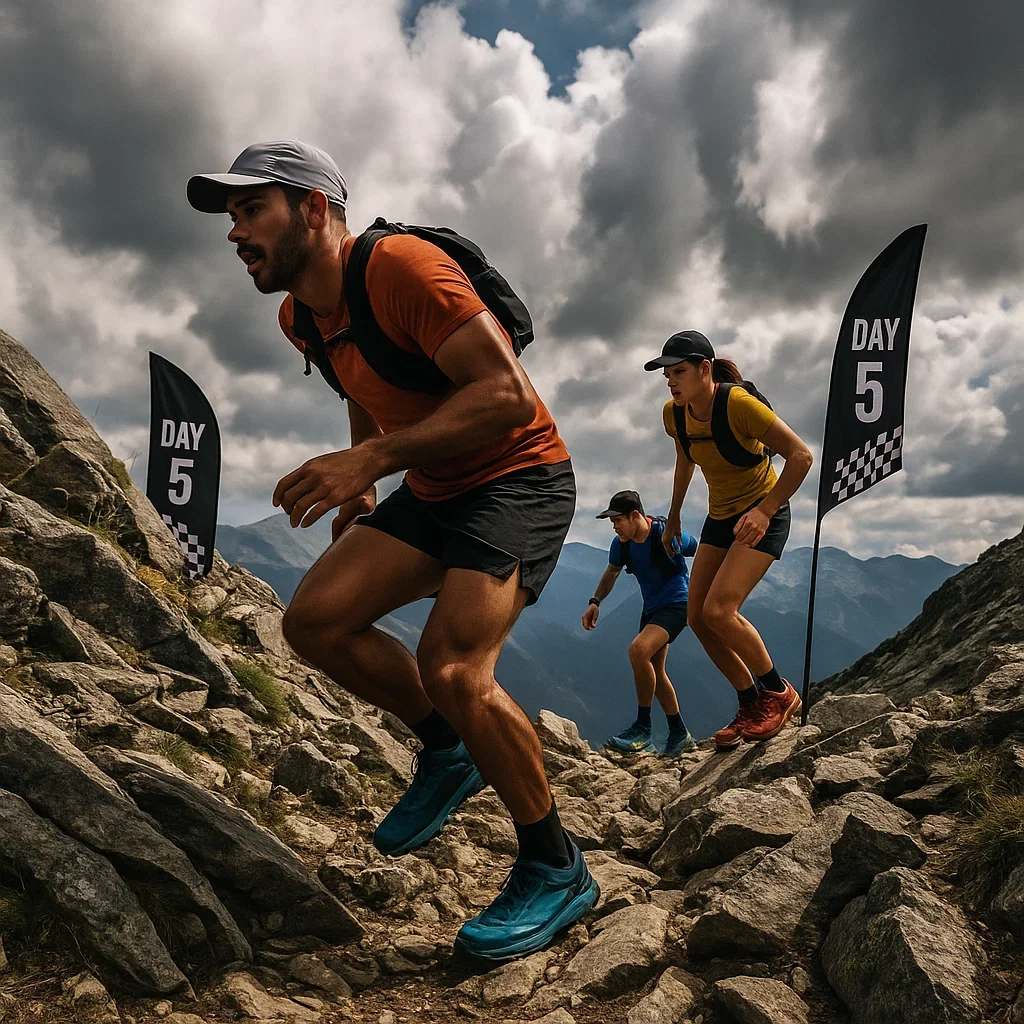
❓ Frequently Asked Questions – Multi-day Ultra Trail Shoes
🥾 What makes a trail shoe suitable for multi-day ultra marathons?
🦶 How many shoes should I bring for a 6-day ultra marathon?
👟 Should I size up for multi-day races?
💧 Are waterproof shoes recommended?
⚖️ Does shoe weight matter for multi-day ultras?
🧦 Which socks are best for stage races?
🔁 How often should I change socks or shoes?
🛠️ What’s in your foot care kit for a 6-day ultra?
👣 How do I manage foot swelling?
🌍 What outsole is best for multi-surface races?
🔋 Will my shoes lose cushioning during the event?
🏕️ How do I store my shoes between stages?
🥶 Any advice for cold or wet conditions?
📦 How should I organize my shoes in drop bags?
💡 Should I use custom insoles or orthotics?
🔥 How do I deal with hot spots or blisters on the course?
🏁 What’s your #1 tip for 6-day ultra runners?
🔗 Further Reading – Expand Your Ultra Knowledge
🌐 Top External Resources
-
iRunFar – Best Trail Running Shoes of 2024
Comprehensive hands-on reviews, including stage race experiences and long-term durability feedback. -
Outside Online – The Best Trail Running Shoes for Every Trail
Expert picks for every surface and ultra distance, with practical notes for multi-day use. -
Runner’s World – Best Trail Running Shoes for Ultra Distances
Lab-tested and reviewed trail shoes, including ultra-specific tips for long-term comfort. -
PubMed – Footwear, Biomechanics and Injury in Ultra-Marathon Running
Scientific research on shoe choice, foot health, and injury prevention in multi-stage races. -
YouTube – Running the 2022 Bigfoot 200 Ultra
Documentary-style footage of a true 200 mile race, including real shoe rotation and foot care scenes.
📝 Quiz: Are You Ready for Multi-day Ultra Shoe Mastery?
-
Which feature is most important for preventing blisters during a multi-day ultra?
a) High stack height
b) Wide toe box
c) Minimal drop
d) Stiff outsole -
How many pairs of shoes should most runners bring for a 6-day stage race?
a) Just one
b) Two to three
c) Five
d) None, go barefoot -
True or false: Waterproof shoes are always the best choice for multi-day ultras.
a) True
b) False -
What is the most common cause of DNFs in multi-day ultras?
a) Getting lost
b) Foot issues (blisters, swelling, pain)
c) Bad weather
d) Wild animals -
Which midsole foam problem can happen after 150+ km?
a) Foam gets bouncier
b) Color changes
c) Cushioning compresses and “dies”
d) Shoes shrink -
What should you always carry in your drop bag for shoe emergencies?
a) Sunglasses
b) Super glue, spare laces, and tape
c) Extra gels
d) A hat -
What’s the best way to test your shoes before race day?
a) Short treadmill runs
b) Back-to-back long runs on trail
c) Just walk around town
d) Try them for the first time at the event -
Which type of sock is best for blister prevention?
a) Cotton socks
b) Wool blends or toe socks
c) Nylon pantyhose
d) Dress socks -
What’s a quick fix for a shoe starting to break down mid-race?
a) Ignore it
b) Use duct tape or super glue
c) Double your socks
d) Buy new shoes on the trail -
When should you change your socks during a multi-day race?
a) Only at the finish
b) Every 6–10 hours or when wet
c) After every meal
d) Never -
BONUS: What should you do if you feel a “hot spot” on your foot?
a) Ignore it
b) Stop and tape or lubricate immediately
c) Wait until the next day
d) Change shoes -
BONUS: What’s the best way to store shoes overnight between stages?
a) Leave them in a sealed duffel
b) Stuff with newspaper, air out, and keep in a dry bag
c) Soak them in water
d) Hang on a tree branch
✅ Quiz Answers
- b) Wide toe box
- b) Two to three
- b) False
- b) Foot issues (blisters, swelling, pain)
- c) Cushioning compresses and “dies”
- b) Super glue, spare laces, and tape
- b) Back-to-back long runs on trail
- b) Wool blends or toe socks
- b) Use duct tape or super glue
- b) Every 6–10 hours or when wet
- b) Stop and tape or lubricate immediately
- b) Stuff with newspaper, air out, and keep in a dry bag
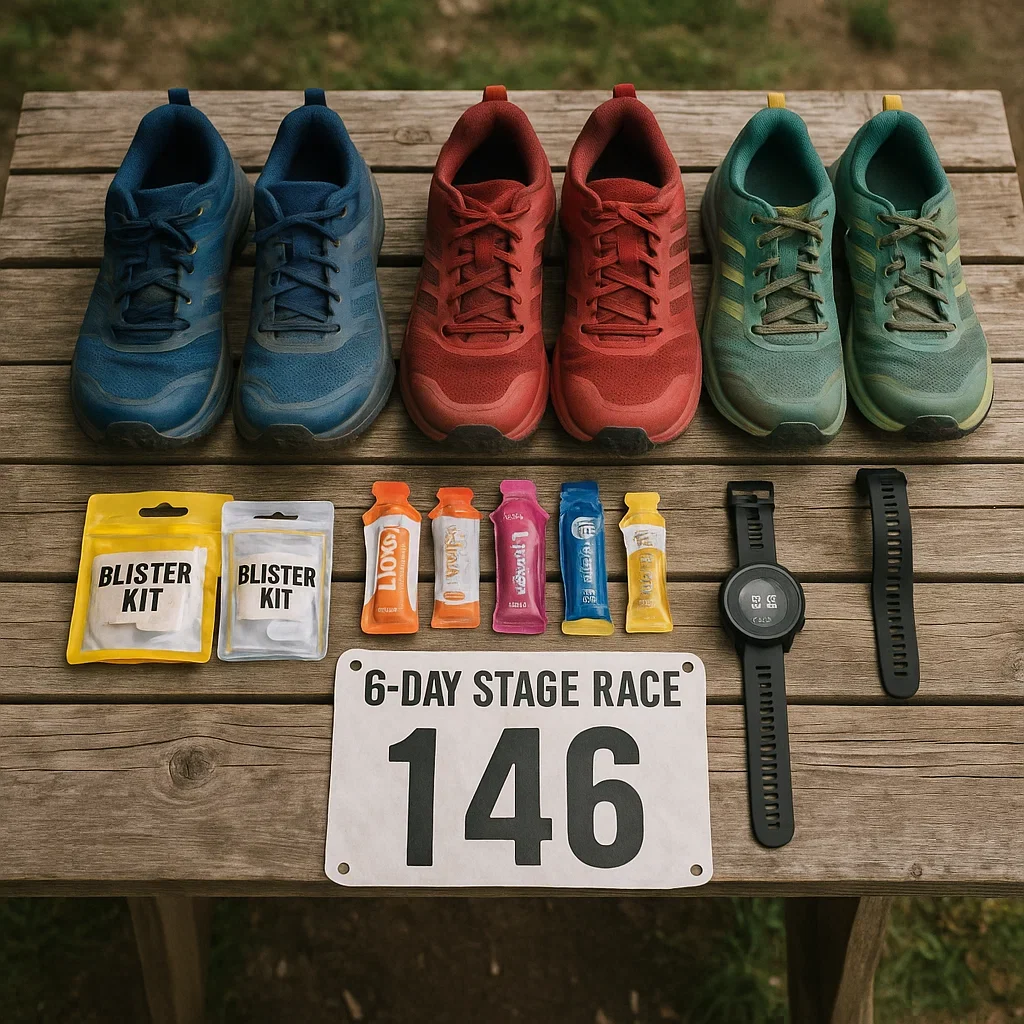
🔗 Share This Multi-day Ultra Guide!
🎥 Video Suggestions – Real Multi-day Ultra & Shoe Strategy
Full-race recap and raw athlete experience from one of the most grueling 200 mile ultras. Great for real shoe rotation and foot care scenes.
Detailed review and comparison of top trail shoes for long ultras and stage races.
Practical tips for multi-day foot care, taping, and keeping feet healthy through tough stage races.
A full-length documentary following athletes through the legendary Tahoe 200—shoes, foot care, and mental toughness in action.
🏁 Final Thoughts: Finish Every Stage Strong
Multi-day ultra marathons aren’t just about running—they’re a masterclass in resilience, foot care, and gear strategy. The right trail shoes are more than equipment: they’re your partner through every sunrise, storm, and finish line.
Test early, rotate wisely, and don’t underestimate the power of a fresh pair of socks at dawn. Every decision adds up. Whether you’re racing for a podium or simply to finish, you’re part of a unique tribe of athletes who know the true meaning of endurance.
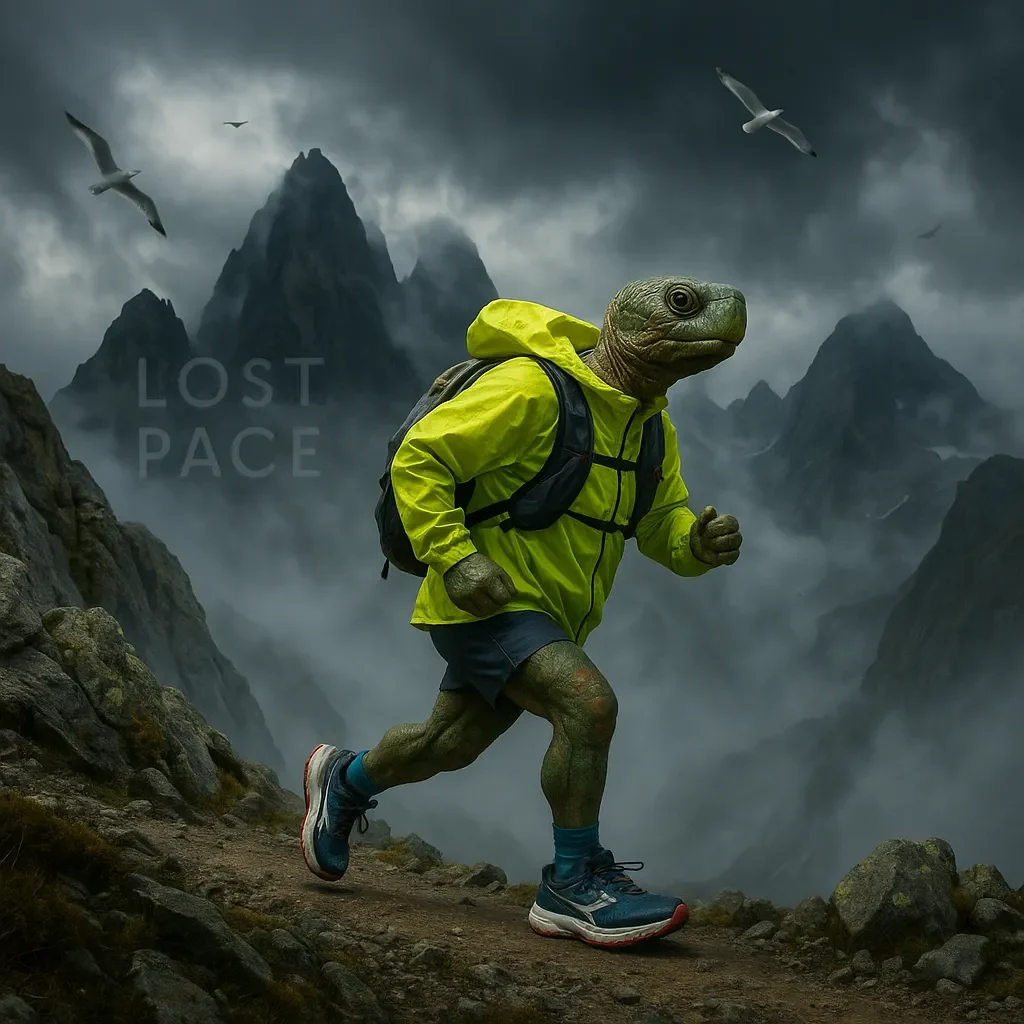
About the Author
Lost Pace is an ultramarathon runner, shoe-tester and the founder of umit.net. Based year-round in Türkiye’s rugged Kaçkar Mountains, he has logged 10,000 + km of technical trail running and completed multiple 50 K–100 K ultras.
Blending mountain grit with data, Lost analyses power (CP 300 W), HRV and nutrition to craft evidence-backed training plans. He has co-written 260 + long-form guides on footwear science, recovery and endurance nutrition, and is a regular beta-tester of AI-driven coaching tools.
When he isn’t chasing PRs or testing midsoles, you’ll find him sharing peer-reviewed research in plain English to help runners train smarter, stay healthier and finish stronger.
Ultrarunner · Data geek · Vegan athlete
